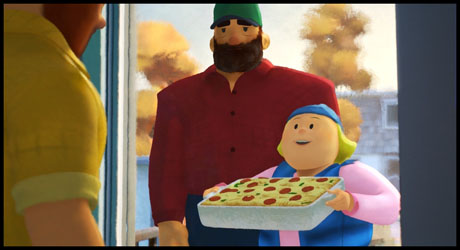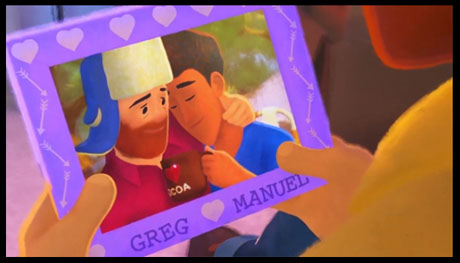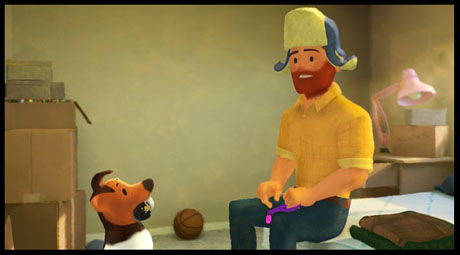
Director Steven Clay Hunter and producer Max Sachar of Pixar’s SparkShorts installment Out are thrilled with the reaction their film has received since it debuted on Disney+ last May. Now, it’s one of the 10 finalists for the Best Animated Short Film Academy Award.
Steven Clay Hunter: It’s crazy. (laughs) Max, you’ve said it the best… it’s like you’re a chef starting your own restaurant and a bunch of people come in. All chefs you respect and admire. All the people in our branch voted for our film. Out of 96 films, it went down to 10, and we got to be one of those 10. It’s like a chef coming into a restaurant going, “Good job. Thumbs up. Yeah!”

Max Sachar: 96 films is a lot. It goes to show also how thirsty people are for animation. How there are folks from all over the world who make animation from bigger studios to smaller studios to that animator who’s been working on something for years and years and years. We love that there’s more and more being made and like Steve said, it’s crazy and overwhelming to think that a lot of those filmmakers and people in the animation industry loved our film.
Jackson Murphy: You’re right that animation is thriving. And you’re on this shortlist with Burrow! I interviewed Madeline Sharafian a couple months ago.
SCH: Yay! Yeah, it’s so good. So proud of that short.
MS: It’s great for the SparkShorts program too. People are seeing that people love these kinds of unique stories that the SparkShorts program is telling. We’re super happy to be alongside Burrow in this group.
JM: What has the reaction been like to Out since it was released on Disney+ back in May?
MS: Steve and I kind of like to describe that experience as very overwhelming. It was very positively received. We were certainly happy and confident going into it, but you never really know what it’s gonna be like until people watch it. Some of the most inspiring reactions we’ve gotten are certainly lovers of short films, lovers of animation, lovers of Pixar products – but also from the families who watch it. People who are watching it with their kids: “It sparked this great conversation about what love is and acceptance.”
SCH: The other spectrum of that was getting notes from 60-year-old men saying, “I wish I had this kind of short when I was younger. It really would’ve helped me coming out.” I found those really touching and moving.

JM: That’s great that you’ve gotten that kind of response, and it’s a very sweet and moving short film. What’s the origins of it? Obviously an important story but also an interesting balance of human and animal characters.
SCH: It’s all true! It happened to me when I was a kid. I was visited by a pink and purple dog and cat who came down from a rainbow and changed my life. It was a great experience! Highly recommend it. (laughs) It came from my cranium. I actually had a dog named Jim, who’s a Jack Russell [Terrier]. Looks just like her in the movie. She always did this thing where she would look at me like she was trying to control my mind. The original version of this was this dog mind-controlling this guy. And as an animator, I was like, “It’d kind of be more fun if the dog was in his body and the guy was in the dog.” That whole “Shaggy D.A.” aspect of the comedy. And then it gradually fit the story better. It quickly turned into the body swap thing early on. And we’re animators. We love dogs. We love animating animals. It’s so fun.
JM: And what was the pitching process like for this?
MS: Steve had been working on the very first SparkShorts films, Smash and Grab and Purl. He had been tasked with helping them form what that was, specific to the animation. Steve, you’ve always been writing in the background of your work as an animator. When he first pitched it to Pete Docter and Jim Morris up in Pete’s office, it was a very loose storyboard version with pink subtitles. I know Steve was incredibly nervous going into that.
SCH: We showed it and you don’t know how people are gonna react, and it was just this sort of nodding of heads. They looked at each other and went, “Okay. All right. Good job. Keep going.” And we just kept making it. There was no drama. And Pete had great story ideas along the way to help us clarify the story.
JM: Steve, did you always know that you wanted a photograph to be at the center of it?
SCH: It was there pretty early on.
MS: It was all about hiding something.
SCH: Hiding his identity. At first there were different things and we kept trying to come up with different things. What are some queer things that he would hide that you don’t want the mom to see? But then we came down to, “It’s about the relationship.” So let’s make it be about the relationship.

MS: It’s easier as an audience member to have this tangible thing that represents something [emotional]. For Greg, it was his boyfriend Manuel.
JM: The scene where Greg’s mom is talking to the dog is so delicate and moving. How did you approach that moment?
SCH: The very first versions of the script had that in there. The mom with the dog saying the things she couldn’t say to her son. Once we got the photograph and the bite… where he would rather bite his mother than reveal his identity to her. Once we committed to that idea… I was like, “I want him to bite her.” That’s what us gays do, we will cut you if you try to cross us. We will cut you. I just felt like that had to be the core of that, and then it’s about her reaction to that and how she feels about being really violently pushed away. [She] says things about Greg – about her relationship with her son – that she couldn’t say to him. The first version was way too long, and then you just kind of pair it down like a really good poem. You get it down to the most succinct version you can. Max and I went over it. We read it out loud to see how it sounded. Does it sound true?
MS: All the way through the recording session, too, with Bernadette Sullivan who played the mother. She was amazing. We started with that scene [in the recording session]… and then went off and did other parts of the movie and then came back to that scene at the end. I feel like the take we ended-up using was pretty much all one take. We didn’t really cut it up and cobble it together. And we always talked about how when we got to that moment, the sound would drop out.
SCH: The second act is so nuts with that music. And Jake Monaco, our composer, he gave me that piece of music when I first started storyboarding it. When I showed Pete, I had that as a track and laid it over the second act. That energy in the second act, but then to go really quiet during the mom speech… and as still as possible.

JM: It’s very well done. And for a fun visual element, you have a dog toy that’s Wheezy from Toy Story!
SCH: Back in 1998, Joe Ranft taught a story class. I got to take his course. I got a golden pointer. When you graduated, you got it. The minute I wanted him to have a squeaky toy, I said, “It has to be Wheezy.” And that’s my nod to Joe [who voiced him].
JM: That’s sweet. Does the success of this short… open the door for a feature film and one that you two would like to team-up on?
SCH: (laughs) Max…
MS: Wouldn’t that be amazing? That’d be fantastic. All doors are open, right? It’s just having the right opportunity and right time to step through it. We certainly basked in the process of making this one.
JM: Are you prepared for the possibility of an Oscar nomination and what you might say if you were to win the Academy Award for Best Animated Short Film?
SCH: I’m definitely not ready. I have no idea. I don’t know what I’m gonna do. On Saturday night I woke up and was like, “What if I have to go?! What am I gonna wear?” For a good two-hour window, from 3 to 5 in the morning, I couldn’t sleep.
JM: Overall, what do you think makes Out a significant entry in the Pixar catalogue?
SCH: I think one of my favorite moments was when we screened this at the Pixar company meeting at Christmastime in 2019. We showed it to the whole company and I came out of the theater and Pete Docter came running up to me and he was like, “Oh my God. That was so emotional.” And I felt like, “Okay. I did alright. We did alright.” And seeing it out in the world and hearing very emotional responses, that to me is what Pixar films do. We try to hit those things. That’s what good film does: make me feel something. I feel like that’s our Golden Ticket. I hope.
MS: People have reached out to us and talked about how in many ways this is the first film of its kind – in its subject matter and protagonist. But Steve and I have always hoped and we know that it’s not the last. This is certainly not the last story of its kind. We just know that there’s a thirst out there for this kind of material and these kinds of characters and stories. We’re just excited to be a part of it.
- INTERVIEW: “Inside Out 2” Director And Producer On Pixar Sequel - April 16, 2024
- INTERVIEW: “Puffin Rock And The New Friends” And 25 Years Of Cartoon Saloon - April 10, 2024
- INTERVIEW: “Chicken For Linda!” Directors On Annecy Winning Feature - April 9, 2024


 February 18th, 2021
February 18th, 2021  Jackson Murphy
Jackson Murphy  Posted in
Posted in  Tags:
Tags: 






